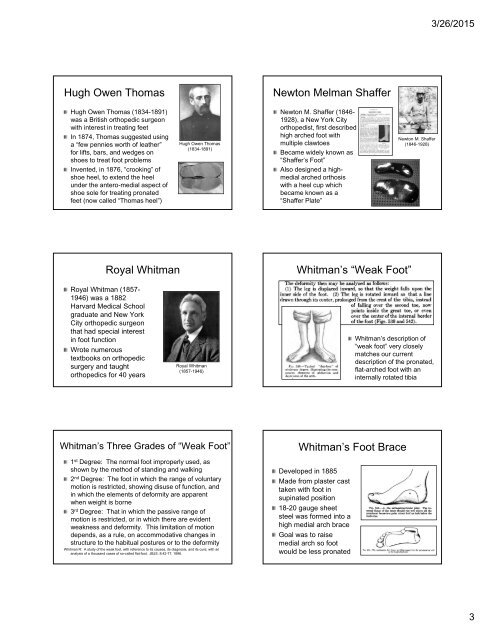History-Evolution-of-Foot-and-Lower-Extremity-Biomechanics-and-Foot-Orthoses_Kevin-Kirby
History-Evolution-of-Foot-and-Lower-Extremity-Biomechanics-and-Foot-Orthoses_Kevin-Kirby
History-Evolution-of-Foot-and-Lower-Extremity-Biomechanics-and-Foot-Orthoses_Kevin-Kirby
You also want an ePaper? Increase the reach of your titles
YUMPU automatically turns print PDFs into web optimized ePapers that Google loves.
3/26/2015<br />
Hugh Owen Thomas<br />
Newton Melman Shaffer<br />
Hugh Owen Thomas (1834-1891)<br />
was a British orthopedic surgeon<br />
with interest in treating feet<br />
In 1874, Thomas suggested using<br />
a “few pennies worth <strong>of</strong> leather”<br />
for lifts, bars, <strong>and</strong> wedges on<br />
shoes to treat foot problems<br />
Invented, in 1876, “crooking” <strong>of</strong><br />
shoe heel, to extend the heel<br />
under the antero-medial aspect <strong>of</strong><br />
shoe sole for treating pronated<br />
feet (now called “Thomas heel”)<br />
Hugh Owen Thomas<br />
(1834-1891)<br />
Newton M. Shaffer (1846-<br />
1928), a New York City<br />
orthopedist, first described<br />
high arched foot with<br />
multiple clawtoes<br />
Became widely known as<br />
“Shaffer’s <strong>Foot</strong>”<br />
Also designed a highmedial<br />
arched orthosis<br />
with a heel cup which<br />
became known as a<br />
“Shaffer Plate”<br />
Newton M. Shaffer<br />
(1846-1928)<br />
Royal Whitman<br />
Whitman’s “Weak <strong>Foot</strong>”<br />
Royal Whitman (1857-<br />
1946) was a 1882<br />
Harvard Medical School<br />
graduate <strong>and</strong> New York<br />
City orthopedic surgeon<br />
that had special interest<br />
in foot function<br />
Wrote numerous<br />
textbooks on orthopedic<br />
surgery <strong>and</strong> taught<br />
orthopedics for 40 years<br />
Royal Whitman<br />
(1857-1946)<br />
Whitman’s description <strong>of</strong><br />
“weak foot” very closely<br />
matches our current<br />
description <strong>of</strong> the pronated,<br />
flat-arched foot with an<br />
internally rotated tibia<br />
Whitman’s Three Grades <strong>of</strong> “Weak <strong>Foot</strong>”<br />
1 st Degree: The normal foot improperly used, as<br />
shown by the method <strong>of</strong> st<strong>and</strong>ing <strong>and</strong> walking<br />
2 nd Degree: The foot in which the range <strong>of</strong> voluntary<br />
motion is restricted, showing disuse <strong>of</strong> function, <strong>and</strong><br />
in which the elements <strong>of</strong> deformity are apparent<br />
when weight is borne<br />
3 rd Degree: That in which the passive range <strong>of</strong><br />
motion is restricted, or in which there are evident<br />
weakness <strong>and</strong> deformity. This limitation <strong>of</strong> motion<br />
depends, as a rule, on accommodative changes in<br />
structure to the habitual postures or to the deformity<br />
Whitman R: A study <strong>of</strong> the weak foot, with reference to its causes, its diagnosis, <strong>and</strong> its cure; with an<br />
analysis <strong>of</strong> a thous<strong>and</strong> cases <strong>of</strong> so-called flat-foot. JBJS, 8:42-77, 1896.<br />
Whitman’s <strong>Foot</strong> Brace<br />
Developed in 1885<br />
Made from plaster cast<br />
taken with foot in<br />
supinated position<br />
18-20 gauge sheet<br />
steel was formed into a<br />
high medial arch brace<br />
Goal was to raise<br />
medial arch so foot<br />
would be less pronated<br />
3


